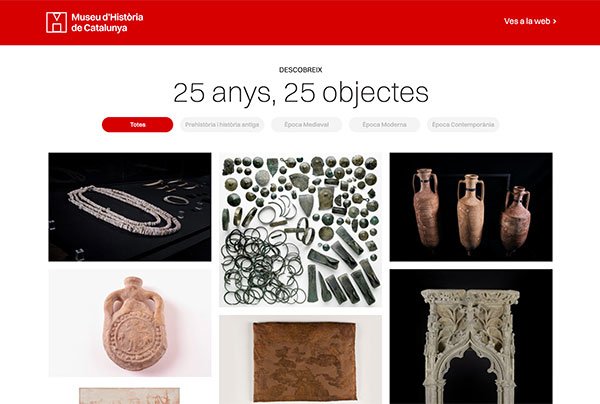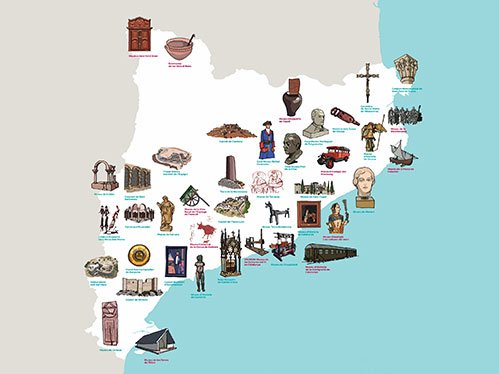Al canviar d'idioma no tots els continguts estan traduïts
The website is not fully translated
Al cambiar de idioma no todos los contenidos están traducidos
Al canviar d'idioma no tots els continguts estan traduïts
 Opening times
Opening times
 Location
Location
 Tickets
Tickets
 Admissions
Admissions
Opening times
Tuesday to Saturday, 10am to 7pm
Wednesdays, 10am to 8pm
Sundays and public holidays, 10am to 2.30pm
The ticket office and entrance are closed 30 minutes before closing time
CLOSED: Mondays that are not bank holidays, 1 and 6 January, 1 May, 18 May, 1 June, 25 and 26 December
Location
Address
Plaça de Pau Vila, 3
08039 Barcelona
Coordinates: 41.380900, 2.185693
Contact
932 254 700
mhc.cultura@gencat.cat
Fax 932 254 758
Group and school bookings:
932 254 244
Monday to Thursday: 10am-2pm and 3.30-5.30pm
Friday: 9.30am-2pm
mhcvisites.cultura@gencat.cat
Transport and access routes
Public transport
Buses V17, H14, D20, V15, V13, 39, 45, 51, 59 and 120
Metro L4 (yellow) Barceloneta
Train to Barcelona Estació de França
Barcelona Tourist Bus: red line; and Barcelona City Tour: eastern route; Museu d’Historia de Catalunya stop.
Parking
There are three paid-for car parks nearby: in Passeig Joan de Borbó, Moll d’Espanya and Moll de la Fusta.
Coaches have parking spaces available near the museum building.
“Bicing” bicycle hire in Plaça Pau Vila.
Admissions
Permanent exhibition
Temporary exhibitions
General admission: 4 euros
Reduced admission: 3 euros
Combined ticket
Permanent exhibition + temporary exhibition
General admission: 8 euros
Reduced admission: 6 euros
 Opening times
Opening times
 Location
Location
 Tickets
Tickets
 Admissions
Admissions
Opening times
Tuesday to Saturday, 10am to 7pm
Wednesdays, 10am to 8pm
Sundays and public holidays, 10am to 2.30pm
The ticket office and entrance are closed 30 minutes before closing time
CLOSED: Mondays that are not bank holidays, 1 and 6 January, 1 May, 18 May, 1 June, 25 and 26 December
Location
Address
Plaça de Pau Vila, 3
08039 Barcelona
Coordinates: 41.380900, 2.185693
Contact
932 254 700
mhc.cultura@gencat.cat
Fax 932 254 758
Group and school bookings:
932 254 244
Monday to Thursday: 10am-2pm and 3.30-5.30pm
Friday: 9.30am-2pm
mhcvisites.cultura@gencat.cat
Transport and access routes
Public transport
Buses V17, H14, D20, V15, V13, 39, 45, 51, 59 and 120
Metro L4 (yellow) Barceloneta
Train to Barcelona Estació de França
Barcelona Tourist Bus: red line; and Barcelona City Tour: eastern route; Museu d’Historia de Catalunya stop.
Parking
There are three paid-for car parks nearby: in Passeig Joan de Borbó, Moll d’Espanya and Moll de la Fusta.
Coaches have parking spaces available near the museum building.
“Bicing” bicycle hire in Plaça Pau Vila.
Admissions
Permanent exhibition
Temporary exhibitions
General admission: 4 euros
Reduced admission: 3 euros
Combined ticket
Permanent exhibition + temporary exhibition
General admission: 8 euros
Reduced admission: 6 euros

Beyond the Trenches (1936-1939). Photographs by Alec Wainman
In July 1936, Alec Wainman was a young man of 23 full of ideals, a pacifist, a Quaker and apolitical. Distraught by the situation developing in Spain, where the Nationalists had risen up against the Spanish Republic, he signed up as a volunteer with the British Medical Unit (BMU), a step that marked the start of a two-year, life-defining journey. He arrived on 31 August in the Spanish Republic to support the people who symbolised hope for the world due to their resistance to the fascist military coup. With him he had his trusted companion, his Leica camera, which bore witness to those people and their experiences. A gifted linguist, he soon learned to speak fluent Spanish, Catalan and Basque, a skill that was not only useful but also bonded him with these peoples.
As in the case of Robert Capa, Gerda Taro and David Seymour’s Mexican Suitcase and Agustí Centelles’ ‘French Suitcase’, Alec Wainman’s ‘English Suitcase’ is also a tale of a lost suitcase.
Eighty years after the International Brigades’ withdrawal and the end of the war, this exhibition aims to commemorate the civilians and volunteers who came from all over the world to fight for the Republic before they fade from our collective memory. The photographs, the result of a 40-year-long quest to recover 1,650 lost negatives of that period, reveal and illustrate their stories.
History of the collection
Timeline of the Spanish Civil War (1936-1939)
The Popular Front coalition (republicans and socialists supported by other left-wing sectors) wins the general elections. Afterwards, riots break out and the political panorama becomes polarised.
A Nationalist armed uprising, led by General Franco and General Mola and supported by the political right-wing opposed to the Spanish Republic, leads to the outbreak of the Civil War. Apart from in the Basque Country, the upper echelons of the Catholic Church side with the rebellion.
The Moroccan corps of the Spanish army, well-trained combat forces, back the uprising against the militia loyal to the Spanish Republic, which is unarmed and unprepared. Nazi Germany and fascist Italy contribute significantly to the Nationalist cause by providing military aid throughout the entire conflict, the precursor of the Second World War. The war in Spain marks the start of total war, a transition from the trench warfare of the First World War to the ‘modern’ warfare of the Second World War, in which aerial bombardments and tanks dominate.
Britain and France sign the Non-Intervention Agreement.
The photojournalists Robert Capa, from Hungary, and Gerda Taro, from Germany, leave Paris and head for Spain to support the antifascist cause of the Spanish Republic.
The British Medical Unit (BMU) is among the first to intervene, followed by some 5,000 international humanitarian volunteers, who come to help the public health system on the Republican side, which has few nurses and has lost many doctors to the Nationalist side.
The first international military volunteers arrive to defend the Spanish Republic. There are more than 40,000 of them in total from 50 countries.
Much of the civil (not governmental) support comes from France, Germany, Italy, Yugoslavia, Great Britain, the United States, Canada, Poland, Latin America and Bulgaria.
In the early stages of the conflict, the Spanish Republic receives aid from the Soviet Union. Though not full aid, it helps the Republic to hold out against the Nationalists. Mexico gives its support to the Republican government throughout the war and takes in a large proportion of the refugees.
Madrid is attacked and bombarded by the Nationalists aided by the Condor Legion, which turns international public opinion in favour of the Republic. The International Brigades launch a worldwide recruitment drive, run mainly by the Communist International, in a bid to defend the Spanish Republic.
The residents of Madrid and the International Brigades mount a heroic defence of the city to the cry of “¡No pasarán!” (They shall not pass!).
The Lincoln Battalion – the American International Brigade volunteers – and the writers Martha Gellhorn and Ernest Hemingway, arrive in Spain to support the Spanish Republic.
Dr. Norman Bethune and his Canadian Blood Transfusion Unit, in collaboration with Dr. Reginald Saxton of the BMU, make medical history by performing blood transfusions with the aid of refrigerated trucks. These units help the Spanish Republic to maintain a front that extends for a thousand kilometres.
The Condor Legion bombs Guernica, a historic town in the Basque Country, an event depicted by Pablo Picasso in his famous painting of the same name. International opinion is mobilised against the fascist aggression. Following the bombardment, approximately 4,000 children are transported to Britain on board the Habana steamship, accompanied by Leah Manning, a co-founder of the BMU. Some 400 of these children will remain in the United Kingdom when the Spanish Civil War ends. These children are among the 34,000 youngsters evacuated to Europe and Mexico during the war.
In Barcelona, conflict breaks out between the various factions of the Republican Popular Front government, followed by a wave of political repression and persecution of the anarchists.
The Nationalists’ victory at the Battle of the Ebro proves decisive, with a Republican Spain divided in two, with Catalonia to the north and the area from Madrid to Valencia in the centre.
The international volunteers are sent home, Many of them, from dictatorial countries such as Austria, Germany, Italy, Hungary and the Soviet Union, end up in concentration camps.
The better part of half a million exiles cross France during the withdrawal that follows the defeat of the Spanish Republic. Many of them are interned in makeshift camps with very poor sanitary conditions.
The Nationalists finally enter Madrid.
General Franco’s absolute victory is declared. He then establishes a single-party regime with himself as president for life and makes Catholicism the state religion.
It is estimated that by that time, half a million Spanish homes had been destroyed.
In three years, a million people died a violent death and half a million had to go into exile.
Opening times
Tuesday to Saturday, 10am to 7pm
Wednesdays, 10am to 8pm
Sundays and public holidays, 10am to 2.30pm
The ticket office and entrance are closed 30 minutes before closing time
CLOSED: Mondays that are not bank holidays, 1 and 6 January, 1 May, 18 May, 1 June, 25 and 26 December
Location
Address
Plaça de Pau Vila, 3
08039 Barcelona
Coordinates: 41.380900, 2.185693
Contact
932 254 700
mhc.cultura@gencat.cat
Fax 932 254 758
Group and school bookings:
932 254 244
Monday to Thursday: 10am-2pm and 3.30-5.30pm
Friday: 9.30am-2pm
mhcvisites.cultura@gencat.cat
Transport and access routes
Public transport
Buses V17, H14, D20, V15, V13, 39, 45, 51, 59 and 120
Metro L4 (yellow) Barceloneta
Train to Barcelona Estació de França
Barcelona Tourist Bus: red line; and Barcelona City Tour: eastern route; Museu d’Historia de Catalunya stop.
Parking
There are three paid-for car parks nearby: in Passeig Joan de Borbó, Moll d’Espanya and Moll de la Fusta.
Coaches have parking spaces available near the museum building.
“Bicing” bicycle hire in Plaça Pau Vila.
Admissions
Permanent exhibition
Temporary exhibitions
General admission: 4 euros
Reduced admission: 3 euros
Combined ticket
Permanent exhibition + temporary exhibition
General admission: 8 euros
Reduced admission: 6 euros







